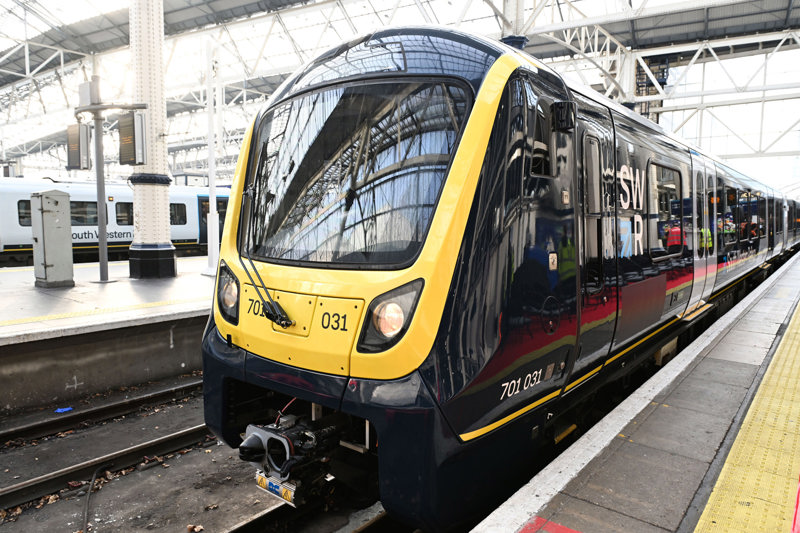
South Western Railway says it could be another two years before its entire fleet of 90 new Class 701 Arterio trains is in service.

South Western Railway says it could be another two years before its entire fleet of 90 new Class 701 Arterio trains is in service.
The Derby-built trains are already five years behind schedule. They were ordered in 2017 to start carrying passengers from November 2019.
SWR has five trains now in daily use. It will add ten more over the next seven months.
They currently run only on Windsor and Shepperton services. From February they will operate on the Hounslow loop, and from March they will run to Dorking and Guildford. From June they will make the longer journey to Reading.
The announcement was made following a ceremony at Waterloo on November 28, when former England cricketer Stuart Broad named a ‘701’ Nighthawk.
SWR called the announcement a “major milestone” and a “monumental achievement” that would “completely transform every single journey” on the suburban network. It said that by next summer, the trains will operate 80 services each weekday.
Interim Managing Director Stuart Meek told RAIL: “This train has arrived later than we expected or wanted. It has been subject to a load of delays.
“We are doing this in phases. We expect the total rollout over the next couple of years. We haven’t got a firm date beyond the ten trains announced today. I don’t want to promise customers new trains without a full programme.”
Rail Minister Lord Hendy sometimes travels to Waterloo on the new trains from his local station. RAIL asked him why a train due in 2019 was something to celebrate at the end of 2024.
He replied: “Because they are coming in now. Because they are better for passengers. There’s more capacity, they’re modern, and they will allow more people to sit down on suburban lines. They will do a good job.”

The former Network Rail chairman added: “You can’t ask someone from this government why, four and a half years previously, they weren’t better planned. I really like them. The old trains rattle at speed, they’re 35 years old, and it’s time for something new.”
So far, 100 of the 750 main line drivers who will work the new rolling stock have completed their two-week conversion course.
Driver Sally Fox took the first Class 701 with passengers on board from Waterloo to Windsor on January 9.
She is now part of the training programme for other drivers. She told RAIL: “The cab is very comfortable. Big seat, great central view, whereas in old traction we are scooped up to the side with a small half window. They are lovely to drive - a fun ride.”
For months, SWR ran one round trip on one route each weekday, using a handful of the 90 trains in turn.
Meek said in January that “unlocking the start of driver training” would “clear the way for the full introduction of the Arterio fleet”, with “more trains entering service in late summer and early autumn.”
SWR said at the time that full fleet introduction would take “12 to 18 months” from then, so the latest schedule amounts to yet further delay.
The vast majority of the trains remain in storage wherever spare sidings can be found. SWR only has capacity to store 12 out-of-use Arterios, so many have been parked at Long Marston and Eastleigh.
The RMT union had previously held 78 days of strike action over the role of the guard on these trains. A guard will be on every service, but the driver will operate the doors on arrival at stations.
Guard trainer Jason Ward said: “The despatch methods we use seem to work. So far, so good. We have trained over 100 guards and 30 guard managers and inspectors. We are hitting our monthly targets.”
Over five years, RAIL has catalogued a litany of delays, safety concerns and technical challenges. Most have related to faulty software.
In 2022, drivers’ union ASLEF wrote to drivers that one train at Wimbledon depot was found to have 90 separate faults. This included 60 generic faults across the whole fleet, and 30 individual faults specific to that unit.
A complex cascade of rolling stock had been based on the availability of Class 701s.
Old Class 442 Wessex Electrics were scrapped, and near-new Siemens Class 707s were transferred to Southeastern.
Twenty-eight Class 458s are being modified in a delayed £25 million programme intended to make them suitable for switching from Reading services to faster 100mph Portsmouth duties. But after returning from refit at Widnes with 2+2 seating, some have been used “temporarily” for suburban services to Weybridge and Twickenham. Plans to run to the South Coast appear to have been abandoned.
Class 455s, which are the mainstay of suburban services, have been kept going years longer than planned.
RAIL previously submitted a request to the Department for Transport under the Freedom of Information Act to discover the cost to the taxpayer of the delay. We asked for this to include the cost of maintaining other rolling stock under extended leases, as well as the cost of storing the unused new trains.
The DfT replied that it did hold the information requested, but it would not release the numbers, claiming this “would likely prejudice the commercial interests of South Western Railway and the Department”.
Eventually the 90 trains (all 750 carriages) will run to Reading, Windsor and throughout the busy south London suburban network of 98 stations.
Login to continue reading
Or register with RAIL to keep up-to-date with the latest news, insight and opinion.


















Login to comment
Comments
No comments have been made yet.